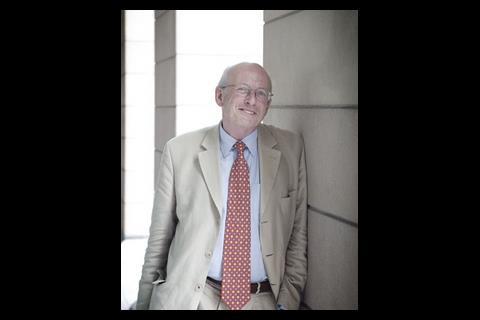The CIC’s new chairman, Nick Raynsford, comes with a clear mission to get the industry’s voice heard by the Government. Andy Pearson finds out what he has to say
Nick Raynsford wants the industry to be heard. One month into his new role as chairman of the Construction Industry Council and Labour’s former construction minister is already making it clear that his objective is to get the government to heed the construction industry. “I see my role as ensuring the voices of all the sections of the industry that make up the CIC are heard where it really matters,” he says in his characteristic precise, well-enunciated manner.
And, as the the single body able to speak with authority to government on all construction issues, it is important the CIC is heard.
Raynsford is an inspired and capable choice to head up the Council. David Adamson, director of construction at the Office of Government Commerce, describes Raynsford as a ‘great success’ as construction minister. He says much of the improvement now working its way through industry is due to him. Raynsford’s political achievements include steering the Construction Act through its final stages in parliament and championing Sir John Egan’s Rethinking Construction Agenda.
Reclining in an armchair next to the window of his Portcullis House office between appointments , the 61-year old appears relaxed and comfortable speaking about his latest role in construction. He says his interest in the industry stems form his time working for a voluntary housing organisation for 13 years after leaving university (where he studied history). After entering parliament in 1986, his involvement continued when he became opposition spokesman on construction in the early ‘90s. When Labour returned to power in 1997, he held the post of construction minister, for four years, until Tony Blair appointed him minister of state for local government and the regions, where he remained until the 2005 reshuffle.
In a slightly crumpled, light linen suit, the MP for Greenwich and Woolwich has something of the air of an amiable favourite uncle about him. Not that his former cabinet colleagues would necessarily agree: since leaving the cabinet, Raynsford has been critical of the government for its ‘relentless merry-go-round’ of construction ministers. “Nowadays I look at construction ministers who come and go in very short order and I have to say I think that is a mistake. I really valued having a four-year term” he says. He is quick to emphasise this independence will be maintained in his tenure at the CIC: “I made it clear in my speech that I am not here as a spokesman for the government,” he states, leaning forward in his chair to stress the point.
Changes
Raynsford is already claiming to have made an impact in changing the way regulatory change is implemented. He is critical of: the way the recent changes to Part L of the Building Regulations were introduced and says he has already spoken to Angela Smith, the new minister responsible for building regulations, who is “working at ways government can rationalise changes to Building Regulations”. As a result, the system of regulatory reform is likely to be revolutionised and simplified so that some of, or all of, the regulations can be upgraded at one time.
One of his main criticisms of government is its fragmented dealings with construction: “I think there is a problem in that the industry has to relate to government through a whole series of different departments and procurement regimes.” He cites the Building Schools for the Future program run by the Department for Education and Skills; the housing program at the Department of Communities and Local Government; and prisons at the Home Office as an example. “it is one of the biggest challenges the industry faces at the moment,” he says, pressing his hands together for emphasis.
It’s a situation, Raynsford says, that is made worse by construction’s decision to move to the DTI. “I said at the time I thought the industry was shooting itself in the foot,” he says, warming to one of his favourite themes. It is clear he still thinks that is the case. “Back in my day, it [construction] was within what’s now DCLG and that was the only industry we were responsible for; we had a team of civil servants that were responsible for construction and related areas like building regulations who could commission research and could support construction trade missions,” he recalls. “I think it was a mistake to transfer responsibility to the DTI where, inevitably, there is a lack of available resource ,” he explains.
It was a mistake to transfer responsibility for construction to the DTI, where there is a lack of available resources
If the DTI is unsuitable, what about the Treasury as some in the industry have suggested? Raynsford says not: “There is no way the Treasury can become a sponsoring ministry for any one individual industry because it has got to take an overview of the whole economy.”
Communication
Returning to his theme of getting the industry heard, he says there is a need for a more regular liaison between industry and the Treasury than exists at the moment. “Treasury needs to be thinking about the wider issues of how the construction industry operates and how it can increasingly add value where there is scope for improvement – for example, in government procurement.”
The industry, too, could do more to help itself and to offer clients better value. Raynsford says he will continue to promote Egan’s “integration agenda” to ensure the “traditional adversarial culture” is pushed out. “I think the problem has been low margins at the letting of the contract, with the contractor then adopting a very adversarial approach towards the subcontractors to maximise their margin and off-load risk onto the subcontractors .” His solution: “You’ve got to change the culture of the industry so that it is incentivised to work together to deliver best value and in so doing to benefit financially.”
Raynsford hopes to bring his experience of regeneration to play at the CIC through increasing the organisation’s focus on sustainability and whole life costing. He thinks it is the energy efficiency of the existing building stock that needs to be addressed in particular. “However good we are at raising standards on new buildings, we are never going to make a significant change if we continue to have such a large proportion of the stock that is energy inefficient,” he says. “We’ve got to be thinking about how to operate existing buildings in the most cost-effective way,” he adds.
Of course, reducing the energy requirement of existing homes makes political sense too: in addition to reducing the impact on the environment it also reduces the UK’s dependence on imported energy.
He does, however, sound a note of caution against the unreserved use of home generation and local micro generation systems: “We have learnt from the past that these technologies have got to work,” he says. “If I think back to all the district heating systems that were being installed enthusiastically in the big council estates in the ‘60s and ‘70s, these were all being ripped out again in the ‘80s and ‘90s to be replaced by individual gas boilers because the big systems did not work as expected. In some cases it was a design problem, in others it was poor management. In some cases it was a combination of the two. The lesson is that we’ve got to make sure that our micro-generation or CHP works and think about costs over time rather than just installation costs”.
Given his enthusiasm for renewables, will the CIC’s new chairman be following in the footsteps of Conservative leader David Cameron?
“I was one of the first people to install a condensing boiler in the early ‘90s; unfortunately it had not been developed properly and didn’t work well – which is why I put the emphasis on installing things that do work,” he says, tactfully evading the question.
Source
Building Sustainable Design
























No comments yet